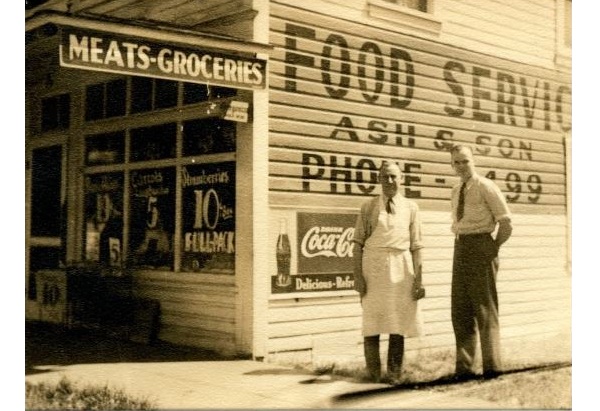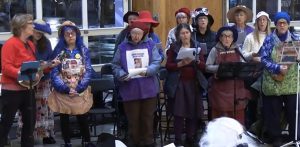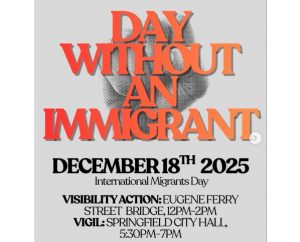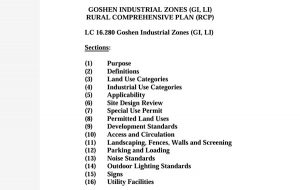As buildings grow ever higher, ‘Eugeneana’ memoirist hopes trees will prevail
8 min read
At the annual meeting of Eugene Neighborhoods Inc., a local author recalls growing up at 781 Monroe. At Roaring Rapids Oct. 10:
A. Lynn Ash (Author, ‘Eugeneana’): My family came to Eugene, my mother and father, my grandparents came to Eugene in 1937. I was born and raised in Eugene. I went to the University of Oregon and graduated from there. I’m a Duck through and through. And members of my family have lived here continuously to the present day.
[00:00:33] In Randy (Prince of ENI)’s original letter to me, he invited me to give a short talk on the character of the neighborhood I described in my book, ‘Eugeneana: Memoir of an Oregon Hometown,’ and the question was: ‘Does neighborhood character exist in Eugene, and is it worth saving?’
[00:00:57] And I’m delighted to have the opportunity to offer my view of that. There are three themes that I would like to touch on in answering this question. And those are number one, the physical landscape; number two, history; and number three, nostalgia.
[00:01:21] My story starts at 781 Monroe at the intersection of Blair Boulevard, Monroe Street, and 8th Avenue. I’m sure many of you know this building. It’s the old two-story building between Sweet Life Patisserie on the north and Beacock Music on the south. I see a nodding head here, somebody who knows about that.
[00:01:50] That building is called the Baldwin Market because the original owner was Earl Baldwin, and he opened a meat market on the bottom floor, sometimes probably around 1917, but we know for sure that it was there in 1920. He was married to Eva, and he and Eva lived in the upstairs apartment.
[00:02:19] You’ve been by that building lately, you notice it’s been painted two different colors. It’s an Airbnb now.
[00:02:29] Now, in 1937, when my family came to Eugene, Earl had vacated the apartment upstairs and he had gone out of business. And my father and grandfather leased the building from Earl and opened a grocery store on the bottom. And you’ll see that on the cover of Eugeneana. They’re standing at the side of their new store.
[00:02:56] My father’s the taller of the two and my grandfather and it says ‘Food Service Ash & Son.’
[00:03:04] Now in the early 1940s (it was 1941 to be exact), my grandfather purchased the Baldwin Market. And in 1946, he and my father began construction on a brand-new market just to the south of our building on the vacant lot next door. And that market was to be Ash & Son, Lane County’s newest and most beautiful food market. And it was, for about five or six years.
[00:03:40] The grand opening for that store was on May 17, 1947 and that building today houses Beacock Music. So the next time you go by Beacock Music give a nod and acknowledge them and say, ‘Hi Bud and Gramps.’
[00:03:59] The Baldwin Market is now on the National Register of Historic Places, as well as being a Eugene historic landmark and it has been since about 1994.
[00:04:18] I left Eugene in the early 1970s and I was gone for 40 years, pursuing a career mostly in California, but I always had my beacon set for home. The family, of course, was the main reason for that, and I missed my mom, I missed my dad, I missed my sister. So every year at least once or twice a year I would drive up from California to visit my family, never dreaming that the time might come when I would lose my hometown.
[00:04:57] But as things happen, eventually my parents passed away, my sister moved away, and suddenly, Eugene was no longer my home. There was no one here to visit, and it was devastating.
[00:05:16] So, my longing for Eugene did not stop. I kept longing for my hometown, and that longing grew and grew and grew until 2010 when I made the decision to come back here, family or not. And so I did, that’s how I came back.
[00:05:37] And there was something that was pulling me back to Eugene that wasn’t just physical family, and that something had to do with the physical landscape and my roots and for nostalgia. And not just for my old neighborhood, but for Eugene, the entire city.
[00:06:02] I’d like to read a few short pieces from Eugeneana that express that. The first piece is a recounting of the moment that I drove back into Eugene to reclaim my hometown.
[00:06:17] ‘I turned off the freeway at 30th Avenue, passed by Lane Community College and eased down the hill, marveling at how the city, buried in green trees and shrubbery, seemed not to exist until the very last curve finally revealed the houses and businesses that confirmed its existence.’
[00:06:38] And the next is an incident that happened six years after I came back to Eugene.
[00:06:47] ‘Today, as I drive down 6th or 7th Avenue, I often make a south turn onto Monroe Street to try to catch a fleeting echo of something familiar, a mood from the old days. It usually doesn’t happen. But then, as I pass by my old home, I look up and there is Spencer’s Butte, deep blue-green mist rising from its flanks and summit, exactly as it was those many years ago.
[00:07:18] ‘As a child on clear sky days, I stood on our porch and looked up at the eternal presence of the butte, looming over the south end of town. It was nothing special to me then, just part of the familiar landscape I was accustomed to.
[00:07:36] ‘Today, six years after returning to my hometown, the dark green eminence of Spencer’s Butte delivers a decidedly emotional punch, filling me with intense love and gladness.
[00:07:51] ‘I place my trust in the immutability of this landmark. No matter what transmutations occur below its summit, Spencer’s Butte will always be there, will always fill me with gladness.’
[00:08:06] And finally, this is an incident that happened when I was a child living at 781 Monroe.
[00:08:13] ‘Back down between our place and the two-story building next door, two enormous maple trees stood side by side, like a portal at the street end of the short alley separating the buildings. Each fall, the leaves of those maple trees, brilliant red, fell and covered the sidewalk and street in glorious profusion. We kids raked the leaves into huge piles and leaped shouting into their crisp coolness, tossing scarlet confetti into the air.
[00:08:49] ‘The trees are long gone now, but I wish they were still there. They should be there, not just because they hold powerful memories for me, but because they were symbols of strength and durability, a statement that the essence of the neighborhood and the era had value and should be cherished, rather than surrendered to the hip indifferent amnesia of a new age.
[00:09:21] ‘This is how the physical landscape of Eugene and its neighborhoods affected me, and probably affects most of you. We find comfort in the lushness around us, especially in our older neighborhoods. We feel embraced by the encircling hills. They are constant, like moms and dads and sisters and brothers—family.
[00:09:47] ‘But now, we see a cluster of new buildings rising in the center of our city, stretching ever upward into the sky. When I see these buildings reaching higher and higher—four stories, six stories, twelve stories—I begin to feel uncomfortable.
[00:10:09] ‘Sometimes I will drive or walk to the top of Skinner Butte and then look out beyond downtown, just a little farther to the east. I find that I’m holding my breath, but I release it. Then I look out and I see that the trees still prevail. They still bury the city in green. When I see that, I hope that will remain true for as long as I live. I hope I will never have to see the buildings rising above the trees.’
[00:10:42] I’d like to turn now to the subject of history as it relates to our neighborhoods. And I’d like to use the Whiteaker area as an example and read another passage, just one more from Eugeneana.
[00:10:59] In 2010, when I returned to Eugene for good, I was conversing with a young man who hadn’t been in Eugene very long. I asked him where he lived. ‘I live in the Whit,’ he said, all pleased as get-out.
[00:11:13] ‘The Whit?’ I echoed. ‘You mean the Whiteaker area? It’s called the Whit now?’ I shook my head. ‘Do you know how that name came about?’ He shrugged. ‘Whiteaker School. Named for John Whiteaker, the first governor of Oregon.’
[00:11:32] ‘Eugeneans trying to be cool, I thought, bandying the jargon, showing off how cool they are, I thought. Eugeneans cultivating their own district like the big cities, places with cool names like The Pearl or the Castro, a place where hip insiders could hang out.
[00:11:55] ‘How apt, I thought, that Whiteaker has been shortened to The Whit—like the history of the area, truncated and forgotten.
[00:12:07] ‘Who now occupying the Red Barn Grocery knows the barn was originally a dairy? Who at (verifying correct spelling) right here at the corner of 6th & Monroe knows that the parking lot was once lined with cars waiting for carhops to bring their food trays? Who at Fisherman’s Market knows that Linda (verifying correct spelling) once pumped gas there at her dad’s gas station?
[00:12:35] ‘Well, the Whit is cool, I suppose. It was cool to the young man I spoke to, and to many of my senior citizen friends, the ones who haven’t lived here very long. But when I give them a bit of history about the places they like to frequent in the area, their expressions change to fascination and surprise, an acknowledgment in a way of their limited perspective.
[00:13:07] ‘But without its history, the Whit, as if a freak standalone place and time, is much impoverished. Without its history, there can be no continuity of story, no true depth of appreciation for what exists there now. Its current trendy name becomes a mockery to the richness of memory, a laugh in its face.’
[00:13:32] John Q: That was a helicopter passing over. We’re meeting outside on prime riverfront property in Glenwood. As Lynn Ash speaks, we can also hear the river, an occasional car stereo, distant trucks, and announcements from Roaring Rapids Pizza, which is hosting several birthday parties tonight.
[00:13:48] A. Lynn Ash (Author, ‘Eugeneana’): Well, let’s now consider the new riverfront neighborhood, in the Riverfront District, brand new, of course. So it’s not probable that the residents there have developed much nostalgia about their environment.
[00:14:05] When I drive up the on-ramp to Coburg Road, I look to the east and I see the ‘Heartland’, a four-story residential building with 95 market-rate units. I see just beyond it the ‘Portal’ on Mill, 130 residential units, market rate, of course. To the west, another enormous four-story residential building is going up. These buildings almost touch the on-ramp, so stark and imposing, and more buildings are coming.
[00:14:42] I wonder: Is this development going to become a valued neighborhood? Will the trees and shrubbery grow and bury these buildings in green? Will children born here want to come back 40 years from now to visit their old ‘hood? How many children will be born here, given the prohibitive cost to many couples of child-bearing age? Are children even allowed here?
[00:15:12] And finally, my last comment: Will someone’s heart be left behind in the River District and sought decades later, just as my heart was left behind and sought decades later at the intersection of Blair Boulevard, Monroe Street, and 8th Avenue?
[00:15:34] John Q: The author of a memoir about Eugene reflects on her love for the city, its history, its buttes, and its trees. (From the annual meeting of Eugene Neighborhoods Inc.)
Eugeneana: Memoir of an Oregon Hometown, is available at J. Michaels Books and Smith Family Bookstore in Eugene.






